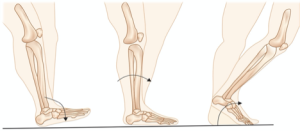News & Events

Gait Training for Stroke Patients
One of the main impairments impacting the ambulatory ability of individuals recovering from stroke is a loss of propulsive force on the affected (paretic) limb. The ReStore Exo-suit was designed with this in mind, to improve paretic propulsion training in individuals recovering from stroke by providing mechanical assistance during plantarflexion and dorsiflexion in-sync with the user’s gait. This allows the person to train with appropriate gait kinematics to perform specific, intense, and repetitive gait training for improved outcomes. To provide the best possible experience utilizing the ReStore, sufficient range of motion should be present to allow the limb to move appropriately through the gait cycle.
During the gait cycle the ankle goes through various stages of plantarflexion and dorsiflexion as it performs the heel, ankle, and forefoot rockers requiring at least 10° of dorsiflexion and 20° of plantarflexion to achieve full functional range of motion for ambulation.
Post stroke, limitations in passive range of motion due to spasticity, soft tissue length, or joint mobility can commonly lead to diminished dorsiflexion range of motion. This has negative impacts not only on clearance during swing phase, but also on the ability to achieve the necessary trailing limb angle required to generate propulsive force during the terminal stance phase. A study by Lewek et. al. in 2019 noted that the posterior positioning of the foot in relation to the pelvis should be considered the trailing limb angle and found that it was related to ground reaction force production. Kathleen O’Donnell discusses this concept in the following highlight clip from our Topics in Neurorehab webcast series:
Resources
- Dhillon S, Dhillon MS, Arumugam S, Gowda PK, Chabbra M, Kumar P. Foot Biomechanics and Relation to the Gait Cycle. J Foot Ankle Surg (Asia Pacific) 2018;5(2):68-72.
- Lewek MD, Sawicki GS. Trailing limb angle is a surrogate for propulsive limb forces during walking post-stroke. Clin Biomech (Bristol, Avon). 2019 Jul;67:115-118. doi: 10.1016/j.clinbiomech.2019.05.011. Epub 2019 May 9. PMID: 31102839; PMCID: PMC6635006.





